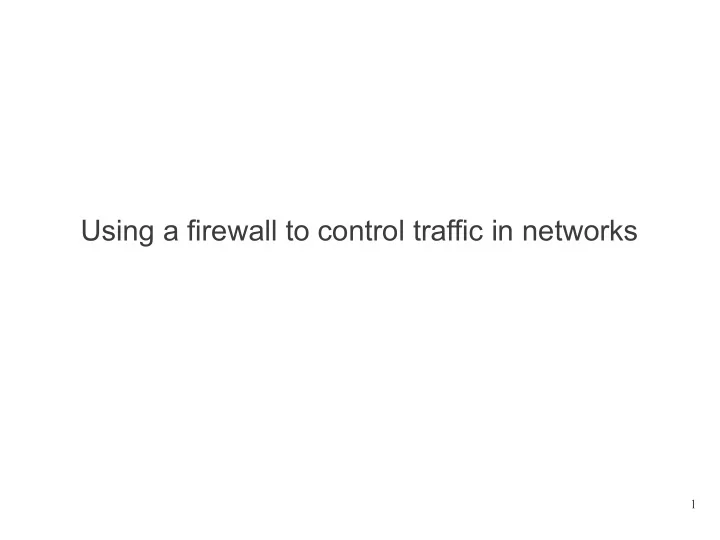

Using a firewall to control traffic in networks 1
Example Network .35 .12 .36 .11 3.3.3.0/24 1.1.1.0/24 Rd .1 Ra .4.1 .4.4 1.1.0.0/16 Rc 2.2.2.0/24 .1 .4.2 .1 .23 Rb .47 Re .15.6 .99 1.1.2.0/24 4.4.4.0/24 .24 2
Firewall on 1.1.1.12 .35 .12 .36 .11 3.3.3.0/24 1.1.1.0/24 Rd .1 Ra .4.1 .4.4 1.1.0.0/16 Rc 2.2.2.0/24 .1 .4.2 .1 .23 Rb .47 Re .15.6 .99 1.1.2.0/24 4.4.4.0/24 .24 3
Block Ping .35 .12 .36 .11 3.3.3.0/24 1.1.1.0/24 Rd .1 Ra .4.1 .4.4 1.1.0.0/16 Rc 2.2.2.0/24 .1 .4.2 .1 .23 Rb .47 Re .15.6 .99 1.1.2.0/24 4.4.4.0/24 .24 4
Block Ping IN: protocol=ICMP; action=DROP OUT: protocol=ICMP; action=DROP .35 .12 .36 .11 3.3.3.0/24 1.1.1.0/24 Rd .1 Ra .4.1 .4.4 1.1.0.0/16 Rc 2.2.2.0/24 .1 .4.2 .1 .23 Rb .47 Re .15.6 .99 1.1.2.0/24 4.4.4.0/24 .24 5
Firewall contains rules ● Each packet is checked against firewall rules ● If conditions in rule are true then perform action on that packet (eg. DROP, ACCEPT) ● If no rules match, then perform default action ● Multiple rules are combined to create a table 6
Firewall on Router Ra .35 .12 .36 .11 3.3.3.0/24 1.1.1.0/24 Rd .1 Ra .4.1 .4.4 1.1.0.0/16 Rc 2.2.2.0/24 .1 .4.2 .1 .23 Rb .47 Re .15.6 .99 1.1.2.0/24 4.4.4.0/24 .24 7
Block Access to SSH Server on .11 .35 .12 .36 .11 3.3.3.0/24 1.1.1.0/24 Rd .1 Ra .4.1 .4.4 1.1.0.0/16 Rc 2.2.2.0/24 .1 .4.2 .1 .23 Rb .47 Re .15.6 .99 1.1.2.0/24 4.4.4.0/24 .24 8
Block Access to SSH Server on .11 .35 .12 .36 .11 3.3.3.0/24 FORWARD: Dst=1.1.1.11; Protocol=TCP; DstPort=22; 1.1.1.0/24 Action=DROP Rd .1 Ra .4.1 .4.4 1.1.0.0/16 Rc 2.2.2.0/24 .1 .4.2 .1 .23 Rb .47 Re .15.6 .99 1.1.2.0/24 4.4.4.0/24 .24 9
Firewall can have different rules ● INPUT: Applies only to packets destined to this computer ● OUTPUT: Applies only to packets created by this computer ● FORWARD: Applies only to packets going through this computer ● These are called chains 10
Block Access to Web Servers on Network 3.3.3.0/24 for .12 .35 .12 .36 .11 3.3.3.0/24 1.1.1.0/24 Rd .1 Ra .4.1 .4.4 1.1.0.0/16 Rc 2.2.2.0/24 .1 .4.2 .1 .23 Rb .47 Re .15.6 .99 1.1.2.0/24 4.4.4.0/24 .24 11
Block Access to Web Servers on Network 3.3.3.0/24 for .12 .35 .12 .36 .11 3.3.3.0/24 FORWARD: Src=1.1.1.12; Dst=3.3.3.0/24; Protocol=TCP; 1.1.1.0/24 DstPort=80; Action=DROP Rd .1 Ra .4.1 .4.4 1.1.0.0/16 Rc 2.2.2.0/24 .1 .4.2 .1 .23 Rb .47 Re .15.6 .99 1.1.2.0/24 4.4.4.0/24 .24 12
Firewall Rules Viewed as Table Firewall table for FORWARD: Rule Source Dest. Protocol Action 1 * 1.1.1.11:22 TCP DROP 2 1.1.1.12:* 3.3.3.0/24:80 TCP DROP Default * * * ACCEPT When packet arrives at firewall, rules are checked row-by-row. If a rule matches, the ACTION is taken and no further rules are checked. Separate tables for INPUT, OUTPUT and FORWARD chains. 13
Recommend
More recommend